Knights in Shining Armor – European Brass Rubbings
PRIMITIVE - Friday, September 04, 2015By Misaki Imagawa
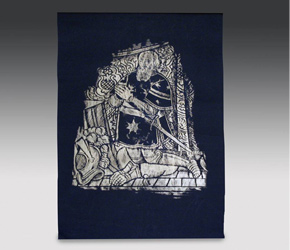 |
|
The Flemish Countryside; 19th Century
The dawn mist took on a golden sheen as the sun broke over the horizon. A young woman picked her way along an animal trail. She walked leisurely, but with intention; her final destination known only to her. One hand lifted her skirt to keep it from getting soaked by the dew along the trail; the other hand held a woven basket slowly filling up with morning berries. She soon arrived at a small clearing, where just the day before she discovered the remains of a tiny medieval church. Only low sections of wall remained, and those were mostly hidden by bushes; but inside she had uncovered something remarkable – an etched brass plate fitted into the stone floor. The plate was almost life size, depicting a knight in full armor, asleep with his hands clasped in prayer.
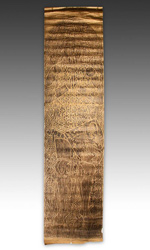 |
|
The woman knelt beside the monument and brushed away a covering of shrubs. After making sure there were no twigs or residue on the brass, she withdrew a long roll of parchment from her basket and a piece of heelball used to polish shoes. She aligned the paper over the knight's figure and began to carefully rub the black wax over its surface. When she was just a child her mother had taught her how to use wax to create copies of artworks. It had become more than a hobby. The application of the wax, the pressure applied, and the sensitivity to the surface underneath – all these combined to make rubbing an art form unto itself. She had always been enamored by medieval tales of feudal knights and their glorious battles. She wondered about the knight whose picture developed on the paper as the image emerged from under her fingertips.
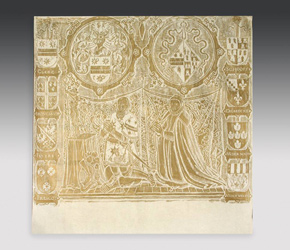 |
|
Memorial brass monuments of knights and clergy flourished in medieval Europe from the 13th to the 16th centuries. Earlier effigies made of wood and stone began to be replaced by brass because of its resiliency, durability and capacity to capture precise details on its surface. These effigies were commonly fitted into the walls and floors of churches as coverings for cavities containing relics of martyrs, tomb covers, and memorial plaques. Known as sepulchral art, these objects were almost exclusively made from brass alloys, which originated along the delta of the Rhine River in Belgium and the Netherlands, called the Low Countries because much of the land is below sea level. The art of creating brass plaques quickly spread along trade routes to other areas of Europe including Germany, France and Britain. These plaques were commissioned for people of all classes except royalty.
Sadly, in subsequent centuries many of these monuments, which could be aptly described as glorious works of art, were lost due to the intrinsic value of the metal and religious conflicts. Countless thousands of monuments were lost on both the European continent and in Britain, until today only a handful of brass memorials remain, mostly in England. Yet, what remains offers rare and valuable insight into the time period. They are one of the very few medieval arts that can be accurately dated. By studying these brass plaques, historians were able to gauge the development of language and genealogies as well as heraldry and fashion of the medieval period. In fact, the practice of brass rubbing actually came about as a means for historians to document and safe-keep the objects they were studying. Much like the woman in the 19th century, scholars got onto their knees and created brass rubbings to create exact detailed copies of the memorials. Soon, it became more than a preservation method – it became an art.
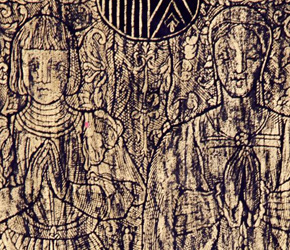 |
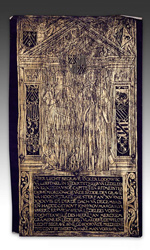 |
||
In the 1960s, an American woman named Jean Farrell lived in Belgium with her husband. She took up brass rubbing as a hobby, and now many of her works have become part of PRIMITIVE's collections. They include beautiful gold and silver crayon rubbings on dark and velvet flocked paper, highly detailed rubbings of calligraphic inscriptions, decorative cartouches, and portraiture. Some of these rubbings show only portions of larger monuments; however, others depict entire life size images. Her skills and techniques faithfully captured the finest etchings, going beyond mere reproductions to become art in their own right.
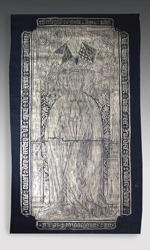 |
|
Many of Jean Farrell’s rubbings depict knights in prayer. Brasses from the Low Countries are often distinguished by engravings of figures on a large single plate, whereas figures in Britain appeared separate from the background. Ultimately, both types were fitted into floors and other surfaces. Belgian plaques were also more floral in design with intricate background details. Older memorials from the 13th and 14th centuries tend to show knights reclined on their backs with inscriptions placed around the edges of the plate. In later centuries inscriptions were shifted to the bottom of the plate. Knights were also frequently shown kneeling in prayer, sometimes with their wives, and occasionally even with loyal hunting dogs at their feet.
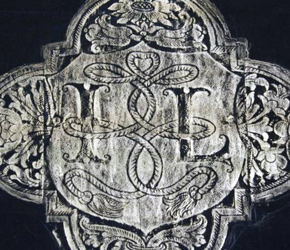 |
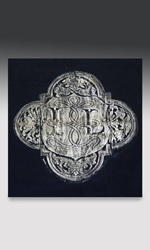 |
||
Around the 16th century brass monuments reached the peak of their popularity. They were produced on a large scale and overall quality dropped significantly. Less attention was paid to overall detail and figures were often etched disproportionately. The monuments chosen by Jean Farrell for her rubbings were clearly early examples, which is evident in the intricate details and fine carvings the rubbings capture. However, soon after she created these works brass rubbing became prohibited. Ironically, those who wished to preserve the information in the monuments slowly but surely wore them down. Consequently, the collection of rubbings at PRIMITIVE can be described as representing a now extinct art form. Not that any of this occurred to the 19th century lady who brought the rubbing back to her home and upon hanging it dreamt of a knight in shining armor.
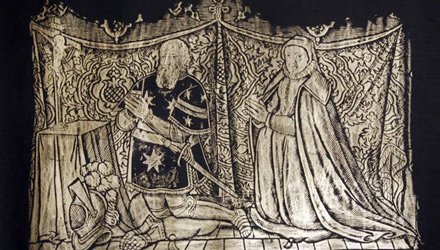 |